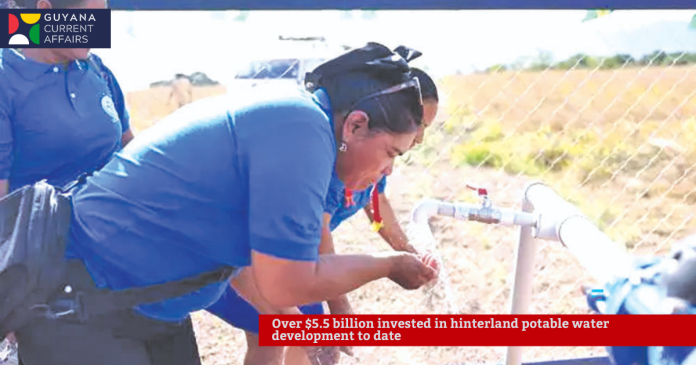The Government of Guyana has announced that more than $5.5 billion has been invested to date in developing potable water infrastructure across the country’s hinterland and riverine communities, dramatically improving access to clean and reliable water for thousands of residents.
This substantial investment has resulted in the drilling of over 100 wells, significantly reducing dependence on creeks, springs, hand-dug wells, and rainwater harvesting. In 2024 alone, approximately $2 billion was spent to construct 56 new wells, granting first-time access to clean drinking water for nearly 2,800 people in underserved areas. For 2025, an additional $2.2 billion has been allocated to expand water supply systems, with the goal of achieving full coverage in the hinterland.
Currently, more than 88 percent of hinterland residents have access to potable water-a remarkable increase from previous years. In some regions, access now stands at over 91 percent, with the government targeting 100 percent coverage by the end of the year.
Region One (Barima-Waini) has seen over $1.5 billion invested in water infrastructure over the past four years, resulting in new wells for communities such as Oronoque, Santa Rosa, and Kumaka. This year, 51 more wells are set to be constructed, with Mabaruma and Moruca among the primary beneficiaries.
Region Seven (Cuyuni-Mazaruni) has benefited from more than $1.2 billion in investments, improving water access for 13,000 households. A new $468 million water treatment plant at Five Miles is nearing completion and will soon provide 24-hour service to residents between Central Bartica and Three Miles. Other communities, including Kurutuku, Jawalla, Kako, and Isseneru, now have functioning water systems, while ongoing projects continue to expand coverage.
In Region Eight (Potaro-Siparuni), over $1 billion has been invested, resulting in the drilling of more than 15 new wells and expanded access for thousands of residents. Recent projects include water systems in Kaibarupai, Monkey Mountain, Kato, Kamana, Itabac, Micobie, and Sand Hill, with further upgrades in Karisparu.
Region Nine (Upper Takutu-Upper Essequibo) has also seen major improvements, with millions spent to enhance water coverage. New wells and elevated storage systems have been installed in villages such as Sawariwau, Sand Creek, Massara, Quarrie, Potarinau, Rewa, and Katoka. This year, $720 million will be used to build additional wells and extend distribution networks in 24 more villages.
The government’s approach includes training Community Service Officers (CSOs) in each village to maintain local water systems, ensuring sustainability and local capacity for ongoing operations.
These efforts are part of a broader national push to improve living standards and achieve universal access to safe, high-quality water in even the most remote communities. The government remains committed to bridging the gap between hinterland and coastal regions, with ongoing investments expected to bring Guyana closer to 100 percent potable water coverage in the near future.


